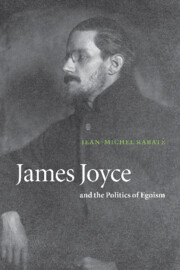Book contents
- Frontmatter
- Contents
- Preface
- List of abbreviations
- 1 Après mot, le déluge: the ego as symptom
- 2 The ego, the nation, and degeneration
- 3 Joyce the egoist
- 4 The esthetic paradoxes of egoism: from negoism to the theoretic
- 5 Theory's slice of life
- 6 The egoist vs. the king
- 7 The conquest of Paris
- 8 Joyce's transitional revolution
- 9 Hospitality and sodomy
- 10 Hospitality in the capital city
- 11 Joyce's late Modernism and the birth of the genetic reader
- 12 Stewardship, Parnellism, and egotism
- Notes
- Bibliography
- Index
4 - The esthetic paradoxes of egoism: from negoism to the theoretic
Published online by Cambridge University Press: 22 September 2009
- Frontmatter
- Contents
- Preface
- List of abbreviations
- 1 Après mot, le déluge: the ego as symptom
- 2 The ego, the nation, and degeneration
- 3 Joyce the egoist
- 4 The esthetic paradoxes of egoism: from negoism to the theoretic
- 5 Theory's slice of life
- 6 The egoist vs. the king
- 7 The conquest of Paris
- 8 Joyce's transitional revolution
- 9 Hospitality and sodomy
- 10 Hospitality in the capital city
- 11 Joyce's late Modernism and the birth of the genetic reader
- 12 Stewardship, Parnellism, and egotism
- Notes
- Bibliography
- Index
Summary
The relation between Joyce's esthetics and his works of fiction has always been a vexed one. The gradual incorporation of the fragments of juvenile esthetics considered as an independent discourse into the very stuff of fiction entails a conspicuous disappearance of “theory” as such. It is less, as we will see, a disaffection of the author with his own theories as a refusal to let theories stand on their own, without a strong link to their enunciator. We have witnessed a similar tension at work in Lacan's theory of the literary symptom accompanied by a no less symptomatic “return of the ego.”
Joyce's perception of his own canon in the making, as evinced by the proud assertion made to his mother from his first Parisian “exile,” announced among other his projects an esthetic theory. In a blustering manner, he outlines a work-schedule filling up the two next decades: “Synge says I have a mind like Spinoza! … I am at present up to the neck in Aristotle's Metaphysics … My book of songs will be published in the Spring of 1907. My first comedy about five years later. My ‘Esthetic’ about five years later again. (This must interest you!).” (LIV, 19). Surprisingly, Joyce was quite right about the first date: Chamber Music was actually published in 1907, while Exiles (if it can be called a “comedy”) was only started in 1914.
- Type
- Chapter
- Information
- James Joyce and the Politics of Egoism , pp. 70 - 84Publisher: Cambridge University PressPrint publication year: 2001



